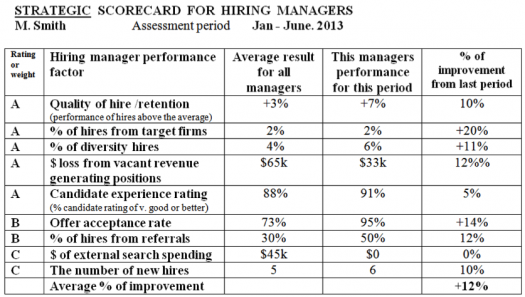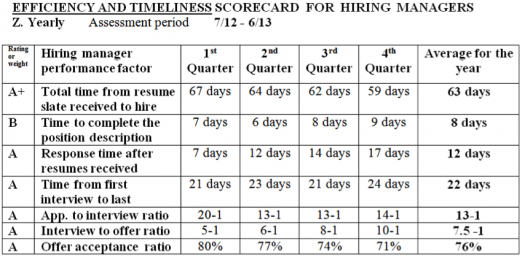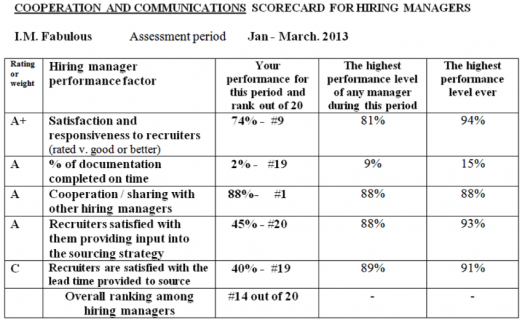Few in the corporate world would argue against the fact that the actions of hiring managers have a significant impact on hiring. In fact, I estimate their impact to be over 50 percent (with recruiters and the corporate employer brand covering the remaining impacts). But unfortunately, I estimate that less than 5 percent of corporate hiring managers are formally assessed or held accountable for their contribution to the hiring process. What is needed is a hiring manager scorecard.
The goal of this scorecard is obviously to identify “problem” hiring managers but it is also to learn and then share the best practices of top-performing hiring managers with all other managers in the corporation.
After setting your overall functional goals, recruiting leaders need to develop these four items.
- Develop hiring and overall recruiting process metrics
- Develop recruiter competencies
- Develop an individual recruiter scorecard
- Develop a scorecard covering individual hiring managers.
I have covered the first three items in recent ERE.net articles, so this one will focus on a hiring manager’s scorecard.
The Benefits of Assessing Hiring Managers
Even though accountability and metrics are widely accepted concepts in the corporate world, they have been slow to filter down into the recruiting process. Accountability is unfortunately not the strong suit of recruiting. Failing to track, assess, and report the results produced by hiring managers essentially encourages “sloppy hiring” and loose compliance with the requirements of the hiring process. The benefits that can result from having an effective “hiring manager scorecard” can include:
- Know what really matters — when you measure and report to senior executives a metric covering an area of hiring, everyone involved unambiguously knows that this area is seen as important by top management.
- Awareness increases the time spent — whatever you measure gets an increased focus, which means that whatever you measure will cause a hiring manager to spend time on it.
- It can identify best practices — by measuring every hiring manager on the same criteria, it is easy to identify the best performers and the practices that result in superior performance.
- It helps to fix problems — measuring hiring manager performance also allows you to identify the worst performers and the problems that they are encountering. Research and analysis can help to identify and eventually share workable solutions to these problems.
- Reporting increases internal competition — the ranked results of each individual hiring manager by name to all hiring managers increases internal competition. In addition, reporting individual results allows weak hiring managers to identify and learn directly from the best hiring managers.
SAMPLE HIRING MANAGER SCORECARDS
Give hiring managers their scorecard divided into three parts:
Part I — The Strategic Scorecard (covering major business impacts)
Part II — The Efficiency And Timeliness Scorecard
Part III — The Cooperation And Communication Scorecard
If you’re wondering what these three scorecards for an individual hiring manager might look like, below you will find three samples, each in a different reporting format (percent of improvement, results by quarter and ranked compared to the very best).
Sample #1 — Strategic Scorecard — A focus on the percentage of improvement in business impacts
This sample scorecard section shows the percentage of improvement of this manager from their last scorecard results. It also compares this hiring manager’s performance to the results produced by the average hiring manager.

Sample #2 — Efficiency And Timeliness Scorecard — A year-long assessment of a hiring manager’s progress
This sample scorecard section lists this manager’s performance in each quarter on efficiency and timeliness and it then summarizes the performance at year-end.

Sample #3 — Cooperation and Communications Scorecard — A performance comparison to the best and the best ever
This sample scorecard section compares this hiring manager’s performance on cooperation and communications during this quarter to the top performance by any hiring manager during this period and the best performance of any hiring manager at any time.

Determining Which Performance Factors to Include
If you’re going to measure and perhaps reward individual hiring managers for excellence, you will need to work with a sample of them to determine which output metrics are strategic, effective, and easy to measure. Next week I’ll recommend a list of 23 possible scorecard measures as a starting point for that discussion.